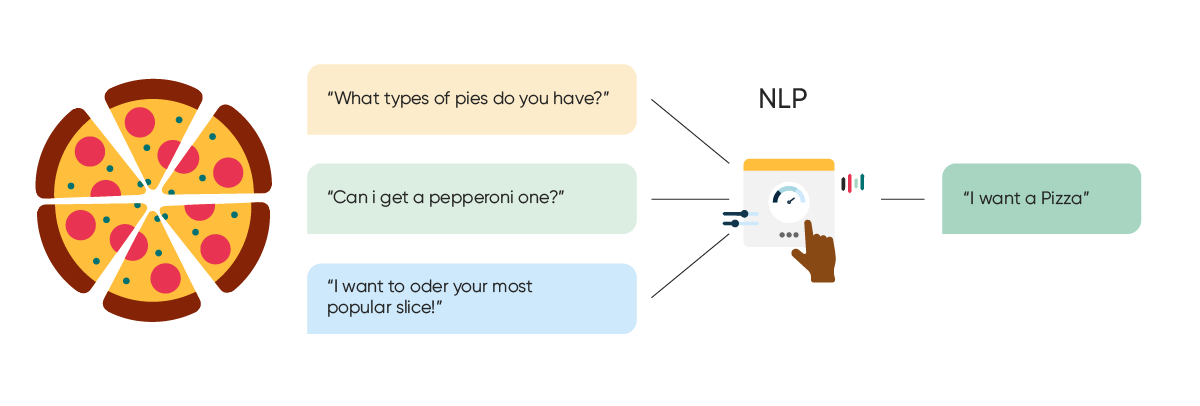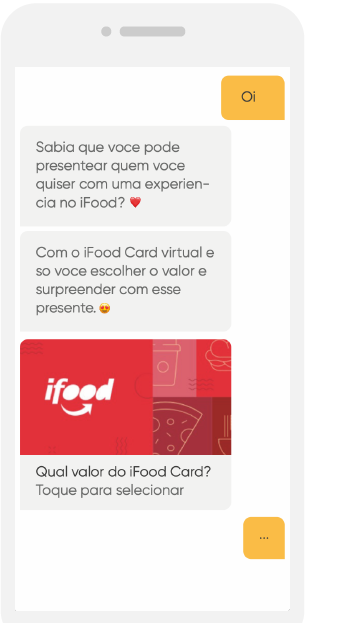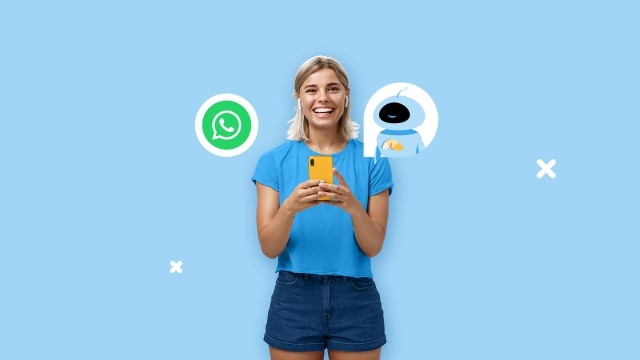NLP, chatbots, AI... you've probably heard all these words before, and then immediately discarded them. Too high-tech. Too complicated. Not relevant for your business. However, behind the technical terms, there are some very real advantages. These technologies can help you boost sales by 67 percent, reduce costs by 30 percent, and increase customer satisfaction. Sounds good? We explain how that works!
If somebody asked you: "Could you use an NLP chatbot for your business?", you would maybe hesitate, and think, "That’s waaaaay too fancy for my company." However, if somebody asked you: "Could you use a technology that could cut your customer service costs by 30 percent, increase sales by 67 percent, and reach a customer satisfaction score of 91 percent?", you would most likely say: "Where can I get it?"
NLP chatbots might sound aloof but bring very real advantages to your business. And they're 100% safe to use! In the following, you'll learn how the technology works, how businesses are using it, and we'll show you the NLP chatbot that outperforms IBM and Microsoft.
What is NLP?
NLP stands for "natural language processing" and is a subfield of artificial intelligence (AI) of computer science. Simply put, NLP enables a computer to understand human speech and text, and reply to them like another human would.
Why is that necessary? Well, because humans speak a natural language, like English or French. Computers, on the other hand, "speak" a programming language, like Java or Python. Unless your clients are proficient at coding, human language has to be translated for computers to understand it, and vice versa. That's what NLP does.
If you have ever talked to a customer service chatbot, or given commands to your GPS system in your car, you have probably already communicated with an NLP chatbot.
How does an NLP chatbot work?
For chatbots to be able to communicate with humans naturally, they must be trained.
When a customer calls a restaurant to order a pizza, for instance, the service agent goes into the call with a lot of background knowledge. The agent knows what types of pizzas there are on the menu, what ingredients can be exchanged, and the agent also knows what questions customers typically ask, from delivery time to forms of payment. For humans, that comes naturally because it’s the way we communicate.
However, a chatbot has to be taught to interact in the same way. This usually happens in three steps.
- Intent classification (understanding the customer)
- Entity recognition (extracting specific information)
- Dialog manager (giving correct replies / taking right actions)
Intent classification
Intent classification means that a chatbot is able to understand what humans want. A restaurant customer service bot, for example, not only needs to be able to recognize if a customer wants to order a pizza or ask about the status of their delivery, but also what type of pizza they want.
Of course, people have many ways of ordering a pizza. A person could say anything from: "I want to order a pie" to "What’s your best slice?" to mean the same thing ("I want a pizza!"). So, NLP chatbots have to be taught to understand different expressions and match them with the correct intent.

Accurate intent classification is really at the core of a good chatbot. The better your chatbot can understand what humans want, the more helpful it can be, both, for your business, and for your customers.
In fact, according to a survey by Uberall, 43 percent of respondents said that chatbots needed to become more accurate in understanding what the customer wants.
This is exactly where the Chatlayer technology stands out! When it comes to accuracy, Chatlayer bots outperform bots that have been developed by Google (DialogFlow), IBM (Watson), or Microsoft (Luis).
Benchmark: Outperforming Google, IBM, and Microsoft
In its latest benchmark report, experts tested Chatlayer's NLP intent classification capabilities, and compared it to competitors. The result: Chatlayer's bot was more accurate in classifying intent.
In addition, the team also challenged its bot in two different ways, first, with an unbalanced dataset, and second, with phrases in Brazilian Portuguese, a less commonly tested language for NLP bots.
Even when using fewer intents and phrases in Brazilian Portuguese, the bot's intent classification was overall still more accurate than Google's Luis, IBM's Watson, and Microsoft's Luis.
🤖 Curious to run it for a spin?
Upgrade your chatbot experience with Chatlayer's NLP chatbot!
Entity recognition
Aside from intent classification, entity recognition and dialog manager, are also important parts of an NLP bot. Entity recognition means to teach a bot to take an entity (a specific word, user data, or context) to understand a human. For example, if a customer wants to buy a pizza supreme, but exchange the mushrooms for jalapeños, the bot needs to understand that “exchange” means to leave out an ingredient, while “for” means to add a different one in order to be able to sell the customer the right pizza.
Dialog manager
The dialogue manager refers to the reply or action that should be taken, based on the detected intents and entities.
Translation vs. NLP
If you've ever worked with Google Translate, then you know that the system is far from perfect. And even the more powerful DeepL makes weird mistakes from time to time. So how is it possible that Chatlayer's NLP bot can understand so many languages? And that without specifying the language up front?
The difference is that the NLP engine actually doesn’t translate into another human language. Rather, it translates whatever a user says to a machine language. And the NLP uses this machine language to determine their intent.
You can, of course, still work with machine translations, but that'll come at a cost. Typically, depending on a language, you lose between 15 and 70% of the performance. With NLP there's no such gap, and you can launch a bot in any number of languages. If you trained your model in only one language, you only need to enriched it with some very language specific expressions.
So you actually don't even have to specify the language because the NLP model can detect the language automatically (and with high accuracy!) What is special about our NLP is that you don’t have to specify which language you are using. This has many advantages for businesses.
How an NLP chatbot can boost your business
As an automated solution, NLP chatbots can be very helpful for companies.
- Business leaders say that chatbots have increased sales on average by 67 percent.
- In a recent survey 57 percent of businesses said that chatbots deliver large ROI for minimal effort.
- An industry report by the Massachusetts Institute of Technology has found that 90 percent of businesses have recorded measurable improvements in the speed of complaint resolution, and 80 percent of companies noted a larger call volume processing through chatbots.
- Chatbots can reduce customer support costs by 30 percent (they can answer faster, and they free up agents).
And: customers also respond positively to chatbots!
- 80% of customers have a positive experience with chatbots
- 22 percent of shoppers trust chatbot recommendations for purchasing a product.
- Using a high-quality chatbot leads to a more engaged audience, with 80 to 90 percent response rates. And even the worst experiences still reach response rates between 35 and 40 percent.
Given these numbers, it’s not surprising that companies have already started using Chatlayer’s highly accurate NLP chatbots successfully.
Examples of successful NLP chatbots
iFood: satisfaction score of 91%
iFood is the biggest online food ordering and delivery platform in Brazil. With growing demand and an increasing number of deliveries, the drivers' customer service at iFood started facing new challenges. They were receiving more calls from drivers who needed assistance during their deliveries. Trying to help the drivers in a timely manner became more difficult, more time-consuming, more expensive, and came at the cost of driver satisfaction.
In order to not only improve the customer service for their drivers, but also the sales and customer service for their end users, iFood implemented the AI bots on most relevant messaging apps, such as WhatsApp and the website.

The chatbot was able to register new drivers and help with the onboarding of new delivery staff. The AI solution also helped with the gift card service, completed consumer surveys, and measure NPS scores.
As a conversational AI chatbot, the bot was not only able to solve technical and logistical issues, but it also received a high satisfaction score of 91 percent from delivery drivers.
European Commission: helping thousands of travelers
Discover EU is an initiative led by the European Commission that helps 18-year-old EU citizens discover Europe by train. As many of these young Europeans are first-time travelers, they naturally find themselves in many situations where they require help on their trips.
After launching the initiative, frequent questions, such as: "What do I do if I missed my train?" or "Where does my train leave from?" ultimately were becoming challenging to handle by the staff of support agents during traditional office hours and across different time zones. As a solution, an FAQ chatbot was developed in order to answer the travelers’ most common questions, which ended up helping thousands of young European explorers on their journeys.
In the first month, the chatbot solved more than 700 questions, and handed over approximately 150 questions to a live support agent.
European Commission
Bizbike: Save more than 40 hours per month
As Belgium’s biggest e-bike provider, Bizbike was looking for a way to keep customers satisfied by offering quick responses and high-quality support. In order to increase the efficiency of their customer service and reduce the workload for their employees, Bizbike implemented a conversational AI chatbot from Chatlayer.
The automated answers were catered to the needs of Bizbike’s customers and made sure to have a smooth transfer between chatbot and agents. The solution was highly successful. Bizbike was able to save more than 40 hours per month through effective automation, and at the same time have an engaging conversation with their customers. Bizbike was able to increase their NPS score from 54 to 56, which means that 62 percent of their customers are actively promoting conversational chatbot solutions and the Bizbike service.
Find out how chatbots can boost your business — on any channel!



